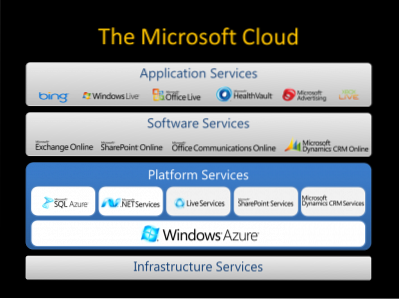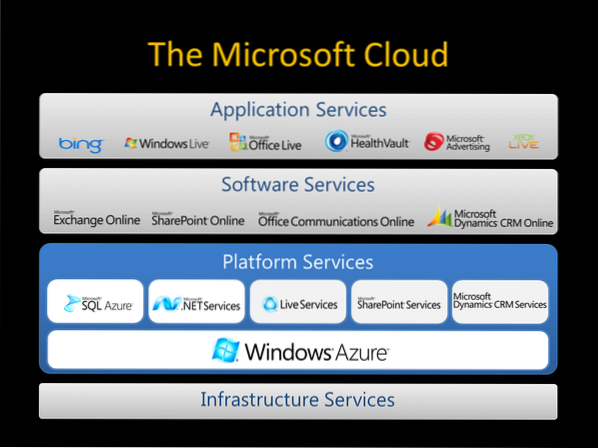We have been discussing Cloud, Cloud computing and also Windows Azure in brief. Now let us quickly take an overview of types of Cloud services existing and what Microsoft Cloud offers us.
Types of Cloud services
We usually get three types of services:
- Infrastructure as a Service (IaaS)
- Software as a Service (SaaS)
- Platform as a Service (PaaS)
Infrastructure as a Service: It is clear from the name that it provides grids or clusters or virtualized servers, networks, storage and systems software designed to augment or replace the functions of an entire data center. In simple words, it provides you with the IT infrastructure which you need as a service. All the servers, networks, VPNs etc are provided as a service to you and you are billed accordingly.
The provider is solely focused on keeping the infrastructure “lights on” within the availability parameters defined within the purchase agreement. IaaS requires highly skilled developer resources within your organization. You simply get out what you put onto the purchased “resource,” and the burden of application deployment, management, monitoring, fail-over, backup, and support lies with the purchaser.
An example is Amazon's Elastic Compute Cloud [EC2] and Simple Storage Service, but IBM and other traditional IT vendors are also offering services, as is Telecom-and-more provider Verizon Business. Microsoft is not much into this space.
Platform as a Service: Provides virtualized servers on which users can run existing applications or develop new ones without having to worry about maintaining the operating systems, server hardware, load balancing or computing capacity.It basically provides you with the set of tools and resources which you need to develop the applications which will run on the cloud and may provide you with the deployment and automatic services management capabilities also.
Examples include Microsoft's Azure and Salesforce's Force.com.
Software as a Service: The most widely known and widely used form of cloud computing, SaaS provides all the functions of a sophisticated traditional application, but through a Web browser, not a locally-installed application. SaaS eliminates worries about app servers, storage, application development and related, common concerns of IT. SaaS in simple words is all about logging into your account with your web browser and use the services.It provides highest level of abstraction to a naive user.
Examples are Salesforce.com, Google's Gmail and Apps, instant messaging from AOL, Yahoo and Google, and VoIP from Vonage and Skype.Microsoft Office Web apps,Office 365,Exchange online etc.
Microsoft believes that PaaS has the best potential to rise and therefore has an offering called Windows Azure Platform which includes Windows Azure, SQL Azure and App Fabric. But besides these it also has lot of offerings under its cloud.

Some of the names you might heard and some you may have not. You must be amazed to see that Microsoft offers such a huge amount of services which is far much richer than any other cloud services vendor. For an end user, applications services are quite handy whereas SMEs should look for Software and Platform Services to start small and go big.
Now read: Public Cloud vs Private Cloud difference.

 Phenquestions
Phenquestions



